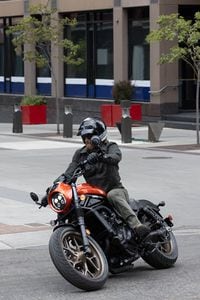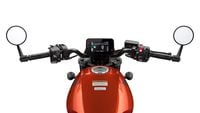Honda probably didn’t put much thought into the name when it unveiled the Rebel 250 in 1985. “Rebel” doesn’t pack the same punch as other period nomenclature like “Savage,” “Eliminator,” or “Intruder.” But 40 years later, the rebellion is real. What’s the Rebel rebelling against? Clutch levers, shifting, and memories of past metric mediocrity. Shifting aside, it’s a popular cause, judging by the new-gen Rebel’s growing popularity since the radically redesigned Rebel 300 and Rebel 500 which debuted in 2017.
Editor’s note: Check out the Is Honda’s 2021 Rebel 1100 DCT Cruiser a Modern Sportster? article/video for added insight on this product.
The larger Honda Rebel 1100 is now in its fifth year of production (read/watch the Top 5 Features of the Honda Rebel 1100T Bagger) and fulfills the gateway promise of its Rebel 500 and Rebel 300 siblings. Besides the striking diamond frame and unapologetically large parallel-twin engine inside it, the Rebel 1100 goes from heretic to apostate by fully embracing automatic transmissions. The previously optional Dual-Clutch Transmission, or DCT, is now standard on this new Rebel. What’s more in-your-face than saying “meh” to the sacred art of shifting?
The new 2025 Honda Rebel 1100 DCT SE continues the evolution of Big Red’s new-school cruiser platform. While the Rebel 1100T brought West Coast style, hard saddlebags, and a fairing, the Rebel 1100 DCT SE leans into DCT (now standard) and tasteful style touches. These include a minimal headlight nacelle, bar-end mirrors, shorter front fender, and ‘70s-tastic Flare Orange Metallic color.
Like the rest of the 2025 Rebel 1100 lineup, Honda’s RoadSync app comes standard, allowing riders to integrate smartphone functions into the TFT with simple voice prompts. Navigation, music, text messages, and calls can be controlled via left handlebar controls and a Bluetooth comms device for hands-free (but not finger-free) control with a charging port added. A small visor has been added to help shield the TFT from sun glare.
Also, the riding position and seat have been updated. How? The press release doesn’t say, though careful photo analysis from Motorcyclist reveals new diamond-style stitching for the Rebel DCT SE seat. Further research reveals the seat is about 10mm (0.4 inch) thicker, and handlebars are 12mm (0.5 inch) higher and pulled back about 28mm (1.1 inches) more than the 2024 models. Footpegs have been moved about 2 inches forward. Importantly, the 27.5-inch seat height remains the same despite the updated seat and ergonomics.
Otherwise, the same 1,083cc liquid-cooled parallel-twin engine with a 270-degree crank gets fed by 46mm EFI throttle bodies. This rows through a six-gear transmission that’s both a “manual” (with hand-controlled paddles) and, of course, automatic. Brakes, suspension, and such remain the same. The Honda Rebel 1100 DCT SE will be available for sale in December, with an $11,099 MSRP.



















/cloudfront-us-east-1.images.arcpublishing.com/octane/QCZEPHQAMRHZPLHTDJBIJVWL3M.jpg)
/cloudfront-us-east-1.images.arcpublishing.com/octane/HXOUJXQWA5HBHGRO3EMJIGFMVI.jpg)

/cloudfront-us-east-1.images.arcpublishing.com/octane/3TIWWRV4JBBOLDVGRYECVVTA7Y.jpg)
/cloudfront-us-east-1.images.arcpublishing.com/octane/KIX5O23D5NAIBGFXBN3327DKZU.jpg)
/cloudfront-us-east-1.images.arcpublishing.com/octane/7GJYDUIPXRGMTMQKN6ONYOLBOU.jpg)
/cloudfront-us-east-1.images.arcpublishing.com/octane/MUQLOVLL2ZDGFH25ILABNBXKTI.jpg)
/cloudfront-us-east-1.images.arcpublishing.com/octane/TNOU5DNE2BC57MFPMGN2EIDXAM.jpg)
/cloudfront-us-east-1.images.arcpublishing.com/octane/GTCXACQGJ5HAPDTGWUQKDEH44E.jpg)
/cloudfront-us-east-1.images.arcpublishing.com/octane/S35YGSEMEZB4BLTDJTSZPF4GLA.jpg)
/cloudfront-us-east-1.images.arcpublishing.com/octane/5UOT6HPX2JFMRJAX6EH45AR4MQ.jpg)
/cloudfront-us-east-1.images.arcpublishing.com/octane/OKWOJWAKP5EP3OACCRRWPCIX2Q.jpg)
/cloudfront-us-east-1.images.arcpublishing.com/octane/2WF3SCE3NFBQXLDNJM7KMXA45E.jpg)
/cloudfront-us-east-1.images.arcpublishing.com/octane/G4MG6OUCJNBSHIS2MVVOTPX65E.jpg)
/cloudfront-us-east-1.images.arcpublishing.com/octane/IIGGWFOTOJGB7DB6DGBXCCMTDY.jpg)
/cloudfront-us-east-1.images.arcpublishing.com/octane/QSTCM6AVEZA5JJBUXNIQ3DSOF4.jpg)
/cloudfront-us-east-1.images.arcpublishing.com/octane/U4I7G625B5DMLF2DVIJDFZVV6M.jpg)
/cloudfront-us-east-1.images.arcpublishing.com/octane/B6XD6LS6IVCQPIU6HXDJSM3FHY.jpg)
/cloudfront-us-east-1.images.arcpublishing.com/octane/ICL63FEDDRDTTMINYICCEYGMDA.jpg)
/cloudfront-us-east-1.images.arcpublishing.com/octane/FCGZHQXRBZFLBAPC5SDIQLVF4I.jpg)
/cloudfront-us-east-1.images.arcpublishing.com/octane/WNOB6LDOIFFHJKPSVIWDYUGOPM.jpg)

/cloudfront-us-east-1.images.arcpublishing.com/octane/X33NU3E525ECRHXLNUJN2FTRKI.jpg)
/cloudfront-us-east-1.images.arcpublishing.com/octane/6KKT5NNL2JAVBOXMZYS5ZO76YA.jpg)